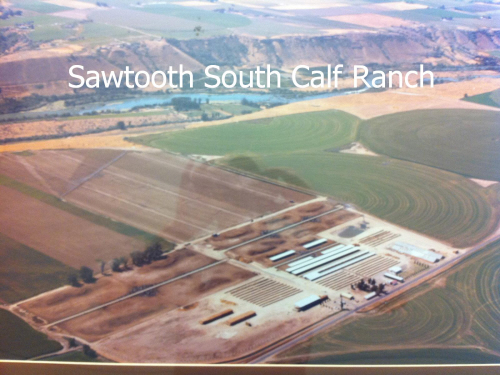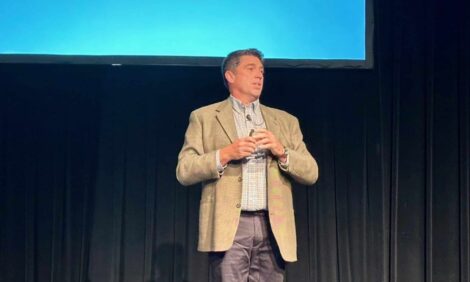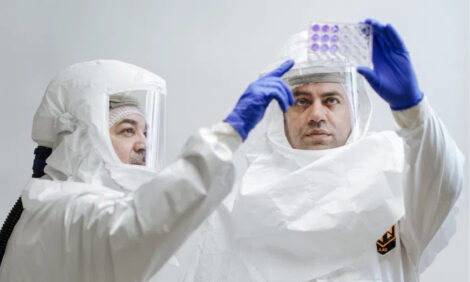



Aardema Dairies: It Pays To Look After Heifers
Jordan Leak is Operations Manager for Aardema Dairies in Idaho. Managing 25,000 cows on seven dairies, Charlotte Johnston, TheCattleSite Editor reports on the company's Sawtooth South Calf Ranch, from the Large Herd Conference.Aardema Dairies compromises of seven dairies, with the herds ranging from 1,000 head to 13,000 head.
Over the last two to three years there has been considerable focus on improving the calf facility, which has 4000 calves on milk at any one time.
Four of the dairies run Holstein herds, however three dairies run pedigree Jerseys.
All heifer calves are reared at the calf ranch, and whilst all replacements for the herd come from this ranch, many heifers are sold on - in the US and abroad.

Colostrum
"There is no replacement for proper colostrum. If you don't get colostrum right - everything else fails," said Mr Leak. Therefore quality colostrum is harvested within two hours of calving.
All milk is tested with a refractometer, with an aim for 21 per cent solids. The milk is then pasteurised and retested.
Mr Leak said that the refractometer is one of the most valued tools on the farm. "It's not expensive for the information one can get out of it, and it is used every day."
All calves (regardless of what breed they are) are fed a total of 7.6 litres of colostrum in two feedings - at one hour and eight hours of life.
Mr Leak said that he ensures all staff who are feeding the calves pay attention to the cleanliness of colostrum. He said if they wouldn't feed it to their children, they shouldn't feed it to the calves.
On top of this, one in three calves are blood sampled to check the serum protein levels are greater than five per cent. This ensures all calves are receiving adequate amounts of colostrum.
Cleanliness
Giving the calf a good start in life, begins with having a clean place for calving, said Mr Leak. He advised that if milk going to the calves is coming from various sources, test it frequently - to check for levels of bacteria. Standard plate counts can be run inexpensively at local milk labs.
Water and grain buckets at Mr Leak's calf ranch, and bedding is replaced as and when is needed.
The calf ranch carries out a lot of diseases testing, and has seen a great return on investment by removing diseased animals from the herd.
Before producing their own milk replacer, the calf ranch found that they had a higher number of treatments per hutch - which Mr Leak puts down to lack of consistency in what calves were fed. Since producing the milk replacer, the farm knows exactly what each calf is fed and where it comes from.

Nutrition
After the initial colostrum is fed, the ranch continues to make its own milk replacer.
Pasteurised milk is fortified with a 25-20 milk replacer (25 per cent protein: 20 per cent fats), to bring it to 16 per cent solids.
"I don't think 12 per cent solids, with a 20:20 milk replacer is adequate for a calf." Mr Leak said he is happy to feed calves as much as they want, in order for them to grow healthy. Healthier calves will eventually produce more milk, he said.
Days 1-7: Calves are fed 3.8 litres of milk replacer a day. Holsteins are fed this is two feedings, however Jerseys are given this in 3 feedings, the smaller portions giving them more time to digest the milk.
Days 8-35: Fed 5.7 litres a day.
Days 36-42: Fed 3.8 litres a day.
Days 43-49: Fed 1.9 litres a day in one feeding.
From day 50, calves are taken off milk, and given a weeks transition period. During this period they are fed with starter mix and water.
By 56 days, calves are fed between 2.7 to 3.6 kg (25 per cent protein) starter, and are moved from hutches to group housing.
Animals are weighed at each ration change. As they get older protein content of feed lowers, whilst the grain/ hay ratio changes.
Between 56-90 days, calves are fed 24 per cent protein, with a 90/10 grain/hay ratio.
Days 90-120: 22 per cent protein. 80/20 grain/hay ratio.
Days 120-150: 21 per cent protein. 70/30 grain/hay ratio.
Days 150-180: 20 per cent protein. 60/40 grain/ hay ratio.
6-12 months: 17 per cent protein ration.
12-14 months: 16 per cent protein ration.
At 14 months, the heifers move to the close up herd, where they are fed a 15.5 per cent protein ration.
Mr Leak said that it is possible to judge how well a system is working by the age and weight that heifers are bred.
This ranch has specific targets for heifers once they reach the age of 12 and 13 months. At 14 months, anything below target weight and height will be culled.
This vigorous system allows Aardema Dairies to average 22.5 months at calving for Holsteins, and 21 months for Jerseys.
The longer a heifer isn't milking, the more money she is costing you, Mr Leak said.
Due to the efficiency of the ranch, and the economies of scale, Mr Leak says that calves can be produced for $1.45/ day, from birth through to first calving.
Concluding Mr Leak asked the audience - does it pay to look after heifers? Evidentially yes is the answer. A good heifer will always pay for herself.


